Anxiety, that all-too-familiar feeling of unease and worry, has long been considered a mental health issue to overcome.
However, there’s a fresh perspective emerging, especially for young adults. Anxiety can be seen not only as a hurdle to overcome but also as an indicator of your brain and sensory health.
In this article, we will explore how anxiety can be a powerful tool for personal growth and development.
Anxiety, in its essence, is your brain’s way of signalling that something needs your attention. In a fast-paced world with a constant flow of information and sensory input, your brain needs to sort through all of this data.
Anxiety can be seen as an indicator that your brain is actively processing and responding to the sensory input it receives.
When you’re anxious, your brain is essentially telling you, “Hey, pay attention! Something might be important here.”
This heightened state of alertness is not inherently negative; it’s a survival mechanism that our ancestors used to detect and respond to threats.
However, in the modern world, it often misfires, causing excessive worry and stress. By understanding this connection, we can start to use anxiety to our advantage.
Embracing the Right Kind of Anxiety
Not all anxiety is harmful. There are two types: state anxiety and trait anxiety.
State anxiety is the temporary kind we feel in response to a specific situation or stressor. It can push us to perform better, motivating us to study for an exam, prepare for a job interview, or meet a deadline.
Trait anxiety, on the other hand, is a more persistent, long-term condition that can be detrimental if left unchecked.
Understanding the difference between the two allows us to harness state anxiety to our advantage. By using it as a motivator for growth and action, we can thrive in various aspects of life.
A Learning Opportunity
Anxiety can serve as a powerful teacher.
When you feel anxious, it’s an opportunity to learn about yourself. What triggers your anxiety, and how do you respond to it?
By exploring your anxiety triggers and reactions, you can gain insights into your fears, weaknesses, and areas where you need to grow.
In turn, this self-awareness can help you make informed decisions about your personal and professional development.
Resilience and Adaptation
Resilience is the ability to bounce back from adversity.
Anxiety can be a training ground for resilience. When you confront anxiety and overcome its challenges, you’re building resilience.
This resilience can help you adapt to life’s uncertainties and setbacks, making you more emotionally robust and better equipped to handle future stressors.
Creativity and Innovation
Anxiety can also be a catalyst for creativity and innovation.
Some of the greatest minds in history experienced anxiety, and they used it to drive their work forward. Anxiety can heighten your senses, sharpen your focus, and force you to think outside the box.
It can lead to novel solutions, new ideas, and unique perspectives that you might not have explored otherwise.
Conclusion
Anxiety isn’t just a mental health issue that should be swept under the rug. It’s a complex interplay between your brain and sensory input, and it can be harnessed to thrive in today’s fast-paced world.
By embracing the right kind of anxiety, learning from it, building resilience, and using it as a catalyst for creativity, you can transform any stumbling block into a stepping stone towards personal growth and success.
Anxiety can be a powerful indicator of your brain and sensory health, and with the right approach, it can be a source of strength and inspiration.

